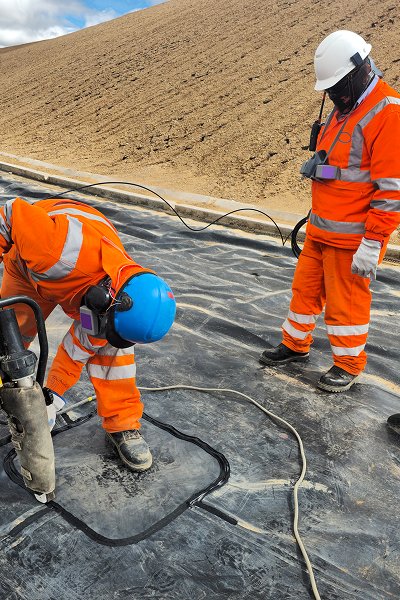Definition and composition of polyester geogrid
Polyester geogrid (PET geogrid for short) is a mesh-like geosynthetic material made primarily of high-tenacity polyester yarn through warp knitting or weaving processes.
Its main functions are foundation reinforcement, pavement enhancement, slope stabilization, and retaining wall reinforcement, significantly improving the bearing capacity and stability of soil or other foundation materials
Structural Composition of Polyester Geogrid
Main Material Layer: High Tenacity Polyester Filament
Made of high-molecular-weight polyester fibers, stretched and combined to form an interwoven mesh structure;
Polyforms extremely high tensile strength (30~800kN/m) and extremely low elongation (≤12%);
Exhibits excellent creep performance under long-term loads, ensuring stable reinforcement throughout the geogrid's service life;
Polyforms excellent acid and alkali resistance, suitable for various complex geological and chemical environments.
Coating Layer: Protection and Enhancement
To improve the durability and anti-aging properties of gratings, a protective coating is typically applied to the surface of polyester gratings. Common coating materials include:
PVC coating: The most common, offering good waterproof, UV protection, and chemical corrosion resistance;
Bitumen (asphalt coating): Enhances adhesion to asphalt pavements, often used for road reinforcement;
Latex coating: Offers better flexibility, suitable for high-humidity environments;
UV Resistant Coating: Used for areas with long-term exposure or high UV radiation.
Performance Characteristics of Polyester Geogrid
High Tensile Strength
Polyester geogrids use high-modulus, high-strength polyester filaments as the main load-bearing material, enabling them to withstand extremely high tensile forces under low elongation conditions. Their tensile strength typically ranges from 30 to 400 kN/m.
Low Elongation
The elongation at break of polyester geogrids is generally ≤12%, far lower than that of traditional plastic geogrids. This means that it can withstand greater stress with relatively small deformations, thus providing reinforcement in the early stages of stress application.
Excellent Creep Resistance
Under long-term loading, materials are prone to creep deformation. Polyester geogrids, made from high-molecular-weight polyester fibers and subjected to a rigorous heat-setting process, retain over 90% of their creep resistance.
UV and Weather Resistance
Polyester grating surfaces are typically treated with PVC, Bitumen, or Latex coatings, effectively preventing UV radiation and oxidative degradation.
Even after prolonged exposure to the outdoors or sunlight, its strength retention remains high, exceeding 90% of its original strength.
Temperature Adaptability
Polyester geogrids maintain stable performance within a temperature range of -45°C to +60°C.
Whether constructed in cold or tropical regions, their mechanical properties remain unaffected.
Application scenarios of polyester geogrid
Road reinforcement and foundation stabilization; used in roads and airport runways on soft foundations to increase the bearing capacity of the structural layer and reduce rutting and settlement.
Slope protection and stabilization; the geogrid interlocks with the soil to form a reinforced structure, improving the slope's resistance to sliding.
Retaining wall and embankment reinforcement; forms a **"geogrid composite"** in the retaining structure to withstand horizontal stress.
Railway and port foundations; suitable for high-load, long-term structures, maintaining uniform and stable foundations.
Landfill and seepage prevention system support; used in conjunction with GCL or HDPE membranesto prevent slippage and settlement.




Key points for the construction of polyester geogrids (approximately 1000 words):
Before construction, the substrate should be leveled and sharp debris removed;
Maintain tension during laying to prevent wrinkles;
Joints should overlap by 10–20cm and be secured with plastic clips or steel nails;
The soil cover thickness is generally ≥15cm, compacted in layers;
If used in conjunction with other geosynthetic materials, it should be laid according to the design direction.
Polyester geogrid, a key representative of modern geosynthetic materials, has become an indispensable reinforcement material in various infrastructure projects due to its excellent tensile strength, low creep, and outstanding durability and stability. From road reinforcement, railway stabilization, and slope protection to soft soil treatment and water conservancy seepage prevention, it plays a significant role in improving the overall strength of structures, enhancing the bearing capacity of foundations, and extending the service life of projects.
Polyester geogrid not only improves the mechanical properties of roadbeds and foundations but also effectively controls settlement and crack propagation, achieving the design goal of "flexible reinforcement, economic durability." Especially in road and railway construction, when used in combination with graded fillers, non-woven fabrics, or drainage layers, it can form a complete composite structural system, thereby maximizing its reinforcement and stabilization effects.


